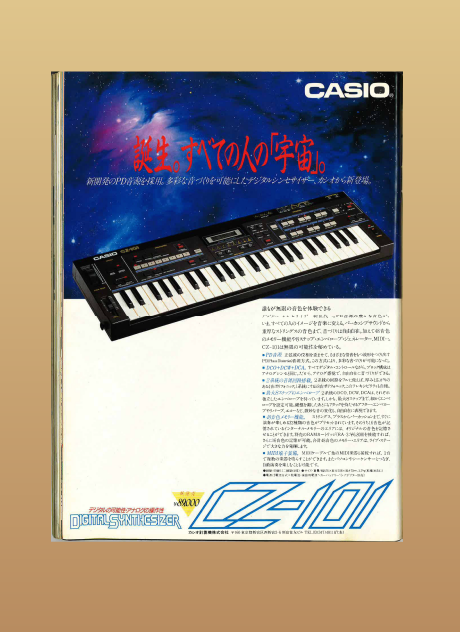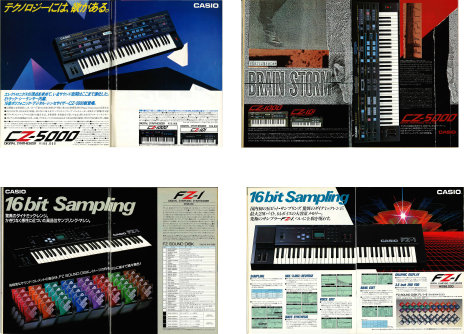CONTRIBUTION
Keyboard Magazine and CASIO Electronic
Musical Instruments
Musical Instruments
~ History of CASIO Synthesizers Began with
Isao Tomita and the Cosmo Synthesizer ~
Isao Tomita and the Cosmo Synthesizer ~

In the November 1980 issue of Keyboard Magazine, Isao Tomita appeared on the cover.
2020 will mark the 40th anniversary of CASIO’s electronic musical instruments. While there isn’t a soul alive today who is unfamiliar with the Casiotone name, it arrived like a bombshell when it first appeared in 1980. Thanks to their outstanding cost performance and extensive capabilities, electronic keyboards – until then expensive instruments for specialists – gained rapidly in popularity and the number of keyboard players rose dramatically. The premier issue of Keyboard Magazine, launched a year earlier in 1979, carried a feature entitled “Keyboards Will be the Star of the 80s!”.
Amidst this Casiotone whirlwind came reports that CASIO had begun development of a full-fledged synthesizer in cooperation with synthesizer master Isao Tomita. Recognizably famous for his worldwide blockbuster hit “Snowflakes Are Dancing”, an album with multiple analog synthesizer recordings released in 1974, Tomita had actively incorporated electronic sounds in works from the earliest days of his career as a composer in the 1950s and was known for regularly using the latest sounds. This collaboration of Tomita with CASIO’s advanced digital technology was the major conversation topic on the keyboard scene.
The results of this effort were published immediately in the November 1984 issue of Keyboard Magazine. The article was a two-page full-color report on Tomita’s “Mind of the Universe” concert at Ars Electronica in Linz, Austria in September of that year. Performed on the banks of the Danube for an audience of 80,000, the performance was an ambitious undertaking that resonated with the “Tomita sound” in 12-channel stereo. At center-stage was a suspended, transparent pyramid carrying Tomita, his “command tower” for every featured component. And inside the pyramid in all its glory stood the Cosmo Synthesizer, the latest synthesizer system developed by Casio.
Amidst this Casiotone whirlwind came reports that CASIO had begun development of a full-fledged synthesizer in cooperation with synthesizer master Isao Tomita. Recognizably famous for his worldwide blockbuster hit “Snowflakes Are Dancing”, an album with multiple analog synthesizer recordings released in 1974, Tomita had actively incorporated electronic sounds in works from the earliest days of his career as a composer in the 1950s and was known for regularly using the latest sounds. This collaboration of Tomita with CASIO’s advanced digital technology was the major conversation topic on the keyboard scene.
The results of this effort were published immediately in the November 1984 issue of Keyboard Magazine. The article was a two-page full-color report on Tomita’s “Mind of the Universe” concert at Ars Electronica in Linz, Austria in September of that year. Performed on the banks of the Danube for an audience of 80,000, the performance was an ambitious undertaking that resonated with the “Tomita sound” in 12-channel stereo. At center-stage was a suspended, transparent pyramid carrying Tomita, his “command tower” for every featured component. And inside the pyramid in all its glory stood the Cosmo Synthesizer, the latest synthesizer system developed by Casio.
The heart of the Cosmo Synthesizer is formed by two types of sound source modules: an SPU and PDU. The “SPU” is a PCM sampler, while the “PDU” is a digital synthesizer that uses a PD sound source; the computer unit to control the modules was equipped with a digital sequencer and also enabled waveforms to be input by hand. This realized a state-of-the-art music environment for the world at that time, with visionary content that anticipated today’s DAW concept. Along with pictures of Tomita at work using the Cosmo Synthesizer, the issue also ran an article describing Casio’s efforts to commercialize the product, which further raised readers’ expectations as well.
One month after those pages had reached readers the CZ-101, CASIO’s first full-fledged synthesizer, went on the market in November 1984. For the audio source component, it came with the PD sound source from the Cosmo Synthesizer series installed. Despite being a state-of-the-art full-digital synthesizer, CASIO had achieved a low price through its adoption of a mini-keyboard, and the product was a major sensation. CASIO broadened the series in the following year, when it introduced the CZ-5000 with a standard keyboard that doubled the number of voices to 32. The CZ series made it easy to create sounds despite being digital, and became the standard electronic keyboard for professionals, with Keyboard Magazine introducing readers to Kitaro, Yuko Hara, Hiroyuki Namba, Vince Clark (Erasure) and other musicians who used the CZ series.
In an interview in the November 1985 issue, Tomita praised the spirit of innovation when discussing the PCM sampler, another of the Cosmo Synthesizer’s modules, noting that “CASIO’s Cosmo Synthesizer achieves a flat frequency response up to 14kHz, far surpassing any other overseas product.” That unit was commercialized in 1987 as the FZ-1. The specs – full 16-bit processing, 36Khz sampling rate and an onboard 2HD disk drive – were state-of-the-art at the time, and high-quality sound was broadly supported. Keyboard Magazine also reported on the series’ appearance in articles covering artists such as Tony Kaye (Yes) and David Bryan (Bon Jovi) during their various tours in Japan.
One month after those pages had reached readers the CZ-101, CASIO’s first full-fledged synthesizer, went on the market in November 1984. For the audio source component, it came with the PD sound source from the Cosmo Synthesizer series installed. Despite being a state-of-the-art full-digital synthesizer, CASIO had achieved a low price through its adoption of a mini-keyboard, and the product was a major sensation. CASIO broadened the series in the following year, when it introduced the CZ-5000 with a standard keyboard that doubled the number of voices to 32. The CZ series made it easy to create sounds despite being digital, and became the standard electronic keyboard for professionals, with Keyboard Magazine introducing readers to Kitaro, Yuko Hara, Hiroyuki Namba, Vince Clark (Erasure) and other musicians who used the CZ series.
In an interview in the November 1985 issue, Tomita praised the spirit of innovation when discussing the PCM sampler, another of the Cosmo Synthesizer’s modules, noting that “CASIO’s Cosmo Synthesizer achieves a flat frequency response up to 14kHz, far surpassing any other overseas product.” That unit was commercialized in 1987 as the FZ-1. The specs – full 16-bit processing, 36Khz sampling rate and an onboard 2HD disk drive – were state-of-the-art at the time, and high-quality sound was broadly supported. Keyboard Magazine also reported on the series’ appearance in articles covering artists such as Tony Kaye (Yes) and David Bryan (Bon Jovi) during their various tours in Japan.



A cosmo synthesizer on display at the Toshio Kashio Memorial Museum of Invention.
Photo:Takashi Yashima
And speaking of CASIO during this period, no one can forget the name Yukihiro Takahashi. With his career as drummer/vocalist of the band YMO, he’s one artist who symbolized the age. In a tour article in the February 1986 issue, he explained that in addition to a CZ-5000 created to custom specifications (designed so a stick could be docked to it), he used a Cosmo Synthesizer as an electric drum sound source and a CASIO RZ-1 rhythm machine for which he provided the samples. The story of how CASIO pursued such formidable product development with Isao Tomita, together with the cooperation with two individuals who represent synthesizer music in Japan, is revealed in other articles from that decade as well.
In 1988 the CZ series evolved into the VZ series, which boasted an iPD sound source that grew out of the PD sound source. According to a Keyboard Magazine article, the thin sound from digital synthesizers often was a problem, and the robust sound of the VZ series proved popular.s
CASIO’s electronic instrument technology has been passed down continuously over the years, to the high-grade keyboard CT-X series introduced in 2018 and Casiotone CT-S200 released in 2019, and to CASIO electronic pianos, beginning with the Privia series and the CELVIANO series. In the years ahead as well, CASIO’s advanced technology will undoubtedly remain popular with various keyboard artists and Keyboard Magazine.
(Author: Hiroshi Takayama)
In 1988 the CZ series evolved into the VZ series, which boasted an iPD sound source that grew out of the PD sound source. According to a Keyboard Magazine article, the thin sound from digital synthesizers often was a problem, and the robust sound of the VZ series proved popular.s
CASIO’s electronic instrument technology has been passed down continuously over the years, to the high-grade keyboard CT-X series introduced in 2018 and Casiotone CT-S200 released in 2019, and to CASIO electronic pianos, beginning with the Privia series and the CELVIANO series. In the years ahead as well, CASIO’s advanced technology will undoubtedly remain popular with various keyboard artists and Keyboard Magazine.
(Author: Hiroshi Takayama)